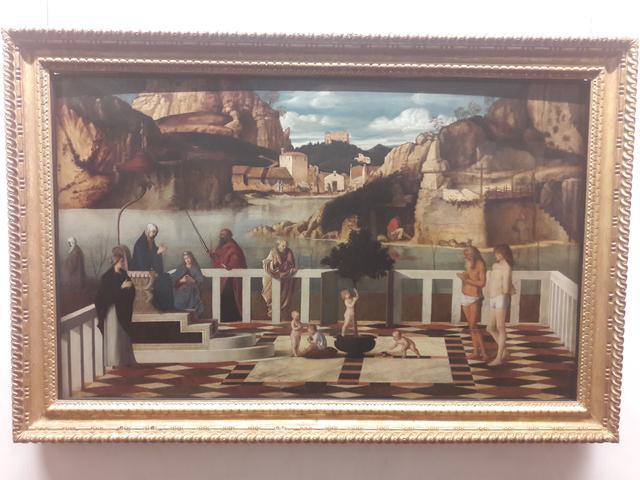The holy allegory

The Holy Allegory is a painting by the Italian Renaissance master Giovanni Bellini, dating from c. 1490 to 1500.
There is no documentation regarding the commission and original location of the work, which is known to have been part of the Austrian imperial collections in Vienna in the 18th century. In 1793, Uffizi director Luigi Lanzi exchanged it with another work to enhance the presence of the Venetian Renaissance in the museum. At the time, it was attributed to Giorgione.
The Italian art historian Giovanni Battista Cavalcaselle was the first to identify it as a Bellini. Today his attribution is widely recognized, although another name sometimes mentioned is that of Marco Basaiti.
The scene takes place on a large terrace with a polychrome marble pavement, in perspective, separated from the shore of a lake by a parapet. On the left, Mary is enthroned, under a canopy whose support is shaped like a horn of plenty, a symbol of her fertility. The baldachin has four steps, and next to it there is a frieze with scenes from the myth of Marsyas, interpreted as a parallel to the Passion of Jesus. Near Mary are two unidentified female figures, which could represent two saints or two virtues. One of them appears to be floating in the air, although the effect could come from a loss of color near its legs and feet.
In the center of the scene are four children playing with a small tree and its silver fruits, perhaps a symbol of the tree of knowledge, a symbol of life and wisdom. On the right are Job and Saint Sebastian. Outside the parapet, there are Saint Joseph (or Saint Peter) and Saint Paul, the latter with his sword attribute. Move to the left, where a man with a turban perhaps symbolizes an infidel.
In the background, beyond a large lake, is a rocky spurred landscape with men and animals. On the banks there is a shepherd in a grotto and a centaur.
© Tourblink